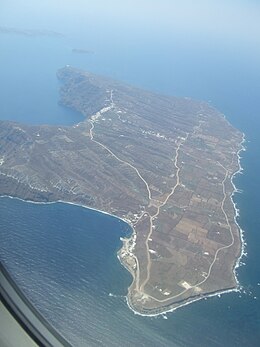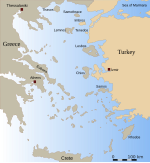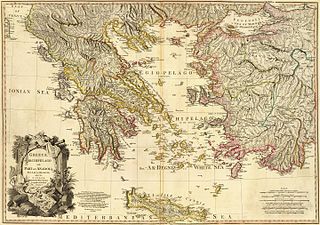
Aegean civilization is a general term for the Bronze Age civilizations of Greece around the Aegean Sea. There are three distinct but communicating and interacting geographic regions covered by this term: Crete, the Cyclades and the Greek mainland. Crete is associated with the Minoan civilization from the Early Bronze Age. The Cycladic civilization converges with the mainland during the Early Helladic ("Minyan") period and with Crete in the Middle Minoan period. From c. 1450 BC, the Greek Mycenaean civilization spreads to Crete, probably by military conquest. The earlier Aegean farming populations of Neolithic Greece brought agriculture westward into Europe before 5000 BC.
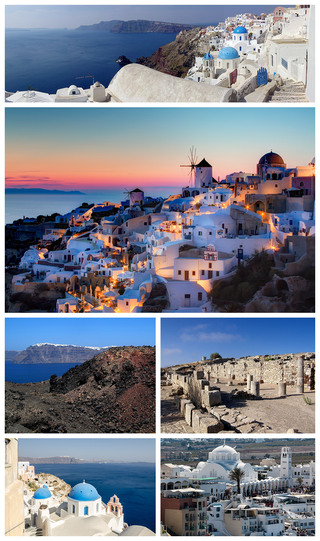
Santorini, officially Thira or Thera, is a Greek island in the southern Aegean Sea, about 200 km (120 mi) southeast from its mainland. It is the largest island of a small, circular archipelago formed by the Santorini caldera. It is the southernmost member of the Cyclades group of islands, with an area of approximately 73 km2 (28 sq mi) and a 2021 census population of 15,480. The municipality of Santorini includes the inhabited islands of Santorini and Therasia, as well as the uninhabited islands of Nea Kameni, Palaia Kameni, Aspronisi and Christiana. The total land area is 90.623 km2 (34.990 sq mi). Santorini is part of the Thira regional unit.

The 17th century BC was the century that lasted from 1700 BC to 1601 BC.

The Minoan civilization was a Bronze Age culture which was centered on the island of Crete. Known for its monumental architecture and energetic art, it is often regarded as the first civilization in Europe. The ruins of the Minoan palaces at Knossos and Phaistos are popular tourist attractions.

Milos or Melos is a volcanic Greek island in the Aegean Sea, just north of the Sea of Crete. Milos is the southwestern-most island in the Cyclades group.

Mycenaean Greece was the last phase of the Bronze Age in ancient Greece, spanning the period from approximately 1750 to 1050 BC. It represents the first advanced and distinctively Greek civilization in mainland Greece with its palatial states, urban organization, works of art, and writing system. The Mycenaeans were mainland Greek peoples who were likely stimulated by their contact with insular Minoan Crete and other Mediterranean cultures to develop a more sophisticated sociopolitical culture of their own. The most prominent site was Mycenae, after which the culture of this era is named. Other centers of power that emerged included Pylos, Tiryns, and Midea in the Peloponnese, Orchomenos, Thebes, and Athens in Central Greece, and Iolcos in Thessaly. Mycenaean settlements also appeared in Epirus, Macedonia, on islands in the Aegean Sea, on the south-west coast of Asia Minor, and on Cyprus, while Mycenaean-influenced settlements appeared in the Levant and Italy.

Spyridon Marinatos was a Greek archaeologist who specialised in the Bronze Age Minoan and Mycenaean civilizations. He is best known for the excavation of the Minoan site of Akrotiri on Santorini, which he conducted between 1967 and 1974. A recipient of several honours in Greece and abroad, he was considered one of the most important Greek archaeologists of his day.
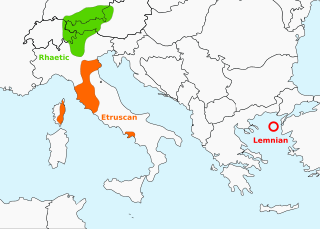
Tyrsenian, named after the Tyrrhenians is an extinct family of closely related ancient languages put forward by linguist Helmut Rix in 1998, which consists of the Etruscan language of northern, central and south-western Italy, and eastern Corsica (France); the Raetic language of the Alps, named after the Rhaetian people; and the Lemnian language of the Aegean Sea. Camunic in northern Lombardy, between Etruscan and Raetic, may belong to the family as well, but evidence of such is limited. The Tyrsenian languages are generally considered Pre-Indo-European and Paleo-European.

Potnia is an Ancient Greek word for "Mistress, Lady" and a title of a goddess. The word was inherited by Classical Greek from Mycenean Greek with the same meaning and it was applied to several goddesses. A similar word is the title Despoina, "the mistress", which was given to the nameless chthonic goddess of the mysteries of Arcadian cult. She was later conflated with Kore (Persephone), "the maiden", the goddess of the Eleusinian Mysteries, in a life-death rebirth cycle which leads the neophyte from death into life and immortality. Karl Kerenyi identifies Kore with the nameless "Mistress of the labyrinth", who probably presided over the palace of Knossos in Minoan Crete.

The Minoan eruption was a catastrophic volcanic eruption that devastated the Aegean island of Thera circa 1600 BCE. It destroyed the Minoan settlement at Akrotiri, as well as communities and agricultural areas on nearby islands and the coast of Crete with subsequent earthquakes and paleotsunamis. With a Volcanic Explosivity Index (VEI) of 7, it resulted in the ejection of approximately 28–41 km3 (6.7–9.8 cu mi) of dense-rock equivalent (DRE), the eruption was one of the largest volcanic events in human history. Since tephra from the Minoan eruption serves as a marker horizon in nearly all archaeological sites in the Eastern Mediterranean, its precise date is of high importance and has been fiercely debated among archaeologists and volcanologists for decades, without coming to a definite conclusion.

Many people have claimed to have deciphered the Phaistos Disc.

Minoan chronology is a framework of dates used to divide the history of the Minoan civilization. Two systems of relative chronology are used for the Minoans. One is based on sequences of pottery styles, while the other is based on the architectural phases of the Minoan palaces. These systems are often used alongside one another.

Akrotiri is the site of a Cycladic Bronze Age settlement on the volcanic Greek island of Santorini (Thera). The name comes from the nearby village of Akrotiri.
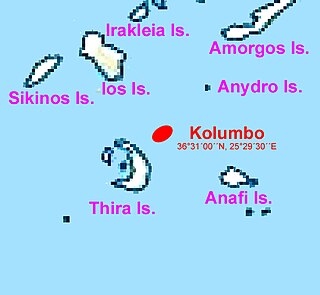
Kolumbo is an active submarine volcano in the Aegean Sea in Greece, about 8 km northeast of Cape Kolumbo, Santorini island. The largest of a line of about twenty submarine volcanic cones extending to the northeast from Santorini, it is about 3 km in diameter with a crater 1.5 km across. It was first noticed by humans when it breached the sea surface in 1649-50. The Smithsonian Institution's Global Volcanism Program treats it as part of the Santorini volcano, though at least one source maintains that it is a separate magmatic system.

Theodora is a feminine given name, the feminine version of Theodore, from the Greek θεόςtheos 'god' + δῶρονdoron 'gift'. Theodora is first attested in Mycenaean Greek, written in the Linear B syllabic script, as 𐀳𐀃𐀈𐀨, te-o-do-ra. The name Dorothy contains the same word elements in reverse order. It was the name of several saints and queens, including Theodora, a 6th-century Byzantine empress honored as a saint in the early Christian Church. Teodora, a variant, is among the top 10 most popular names for girls born in Serbia between 2003-2005.

Santorini caldera is a large, mostly submerged caldera, located in the southern Aegean Sea, 120 kilometers north of Crete in Greece. Visible above water is the circular Santorini island group, consisting of Santorini, the main island, Therasia and Aspronisi at the periphery, and the Kameni islands at the center. It has been designated a Decade Volcano.

The Museum of Prehistoric Thera is located in Fira, on the island of Santorini in Greece. It was built on the site of the old Ypapanti Church which was destroyed in the 1956 Amorgos earthquake.

Manolas is the main settlement and the capital of Therasia, the small island opposite to Santorini (Thera). It is located in the east of island, above the abrupt Santorini caldera. It has a beautiful view of the volcano and the main settlements of Santorini such as Fira, Imerovigli, Oia, etc. Manolas can be approached either by road from the port of Riva or the uphill path from the small port of Korfos. Donkeys are the main mode of transport on this path. Manolas has a population of 140 inhabitants according to the 2021 census. It belongs to Thira municipality and Oia municipal unit.

The Akrotiri Boxer Fresco, discovered in 1967, is one of the Wall Paintings of Thera and a leading example of Minoan painting. It is a fresco depicting two young boys wearing boxing gloves and belts and dates back to the Bronze Age, 1700 BC. Around 1600 BC, a disastrous earthquake, followed by a volcanic eruption, covered Akrotiri, Greece in a thick layer of pumice and ash, which resulted in the remarkable conservation of frescoes, including the Akrotiri Boxer Fresco, from multiple buildings throughout the town. This particular fresco was found in room B1 of Building Beta along with the Antelope Fresco. The boys' shaved heads and stray locks indicate their youth, while their darker skin tone indicates their gender. The boy on the right is completely nude except for a belt, whereas the boy on the left has jewellery; most likely markers of a higher status. They appear to be slightly over life-size at roughly 5 ft 10 in (1.78 m). To create such vibrant frescoes, a smooth lime plaster was applied to the walls and then painted over. It is impossible to know whether the match was a competitive one or simply a routine sport.

Aspronisi is an uninhabited island lying within the Santorini caldera. The island was originally formed by the massive Minoan eruption in the 2nd millennium BC, after which it was gradually built up by successive volcanic activity. The name Aspronisi, which means 'White Island' in Greek, is derived from the island being partially composed of white pumice.
